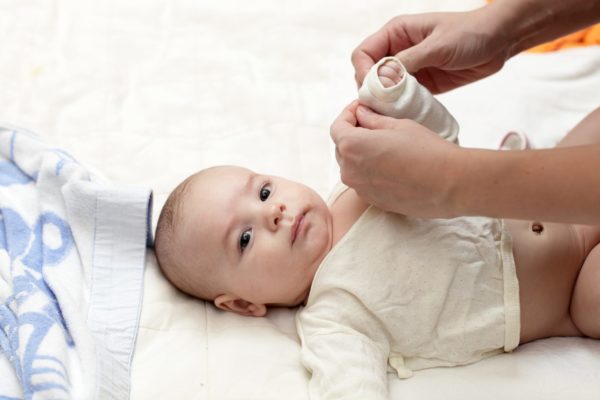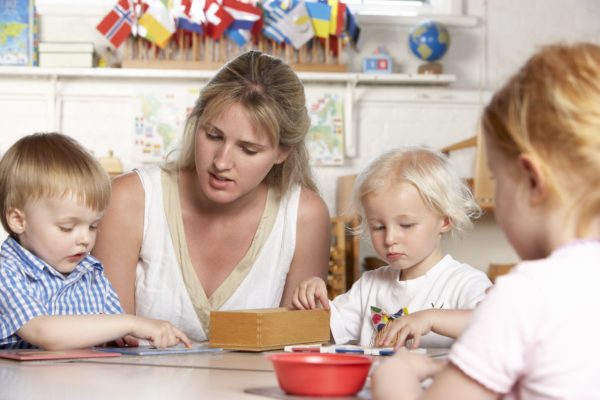So, you’ve been researching parenting philosophies in regards to newborn and toddler care. You’ve likely come across information about RIE. RIE is one of many different child development ideologies.
You’ll find it discussed among other approaches like Waldorf, Reggio-Emilia, Charlotte Mason, and yes, Montessori. But can you implement Montessori and RIE together?
What Is RIE?
If you’ve yet to encounter RIE in your Montessori research, it really was just a matter of time. This is a fairly popular parenting philosophy. In newborn care circles it has been gaining a lot of attention. In the Montessori community as well.
So, just what is RIE anyway?
RIE-or Resources for Infant Educators—is a parenting philosophy founded by early childhood educator Magda Gerber. The RIE approach emphasizes respect for a child from the time of birth as well as acknowledgement of the newborn as a unique and complete human being.

Some of the basic principles of RIE include the following:
- All children deserve respect, regardless of their age.
- Infants should be trusted to guide their own learning and development.
- One of the primary functions of a caregiver is to observe.
- Even babies can (and should) participate in their own care.
- Parents should prepare safe, predictable environments for babies to freely explore.
- Time and space for uninterrupted play is crucial to early childhood development.
- Consistency is the key to discipline.
Just by scanning these basic concepts behind RIE, you are probably already picking up on some similarities between this philosophy and Montessori. Let’s dig a little deeper, though.
How RIE Complements Montessori
The Child-Centered Environment
Both RIE and Montessori emphasize the need for a child-centered environment. Both philosophies direct teachers, parents, and caregivers to spend time preparing the environment and anticipating what the child needs in order to explore, learn, and develop optimally.
In Montessori, the prepared environment may include exploration areas and exhibits where children can participate in self-guided interaction and learning. Since RIE is focused on newborns and infants, the space may look different.
It could include baby gates, for instance, as well as age-appropriate toys that are safe babies to engage with independently.
Still, the concept is the same. That is, the environment is carefully thought-out to provide as much opportunity for free discovery and choice as possible while still establishing clear boundaries for appropriate play and behavior.
Self-Directed Learning
Another tenet shared by both RIE and Montessori is the concept of self-directed learning. This means that instead of pushing children to engage in certain learning activities, parents and teachers should “follow the child” instead and act as facilitators as children select their own learning experiences.
The idea of self-directed learning stems from the belief that little ones (even newborns, according to the principles of RIE) have an innate sense of what they need to learn and how to best go about learning it.
Neither RIE or Montessori advocate for competition or comparison amongst children. Instead, both philosophies espouse the belief that each individual child has his or her own timeline for learning and development and encourage caregivers to honor this timeline.
Freedom and Time to Explore
Some critics of Montessori complain that teachers are standoffish and play a minimal role in the learning environment. What they may not realize, though, is that this removed approach is by design.
In Montessori, children are given time and space to engage in their play (called “work” in a Montessori context) independently and without interruption. Montessori practitioners believe that this is a crucial element in a child’s learning and development process.
Also, in Montessori, the teachers (often called “guides“) are not supposed to take center stage in a classroom, but to blend into the background, unless giving a presentation or assisting a child with a material or a behavior.

RIE takes a very similar approach in the care and instruction of babies. Instead of advocating for the ever-present doting mother, RIE believes that the parent’s role should primarily be that of an observer and facilitator.
As in Montessori, RIE moms and dads are told to look for cues from their children and follow these cues to facilitate growth and development. Gerber calls this tactic “sensitive observation.”
In both Montessori and RIE, parents and caregivers are encouraged to simply observe children. This happens even during times of distress and conflict.
For example, in RIE, moms and dads are taught not to respond right away when their baby cries. But to simply listen and give infants the opportunity to communicate as best they know how.
Long term, this approach teaches children that negative emotions are ok (i.e., not emergency situations). This could lead to better coping mechanisms and overall mental health down the line.
Similarly, Montessori advocates that teachers and caregivers allow older children the freedom to work out conflict on their own. In a classroom setting, kids are encouraged to develop their own solutions to disputes over wooden toys or other resources.
This is happens in place of always going to the teacher for help.
This hands-off approach sends the message to children that they are capable of resolving problems and gives them the confidence to navigate other situations that may arise in the future.

Practical Life Activities in Montessori and RIE
A big part of Montessori is the practical life curriculum. Even for grade-school children, there is a focus on daily life tasks such as cleaning, cooking, tending a garden, and caring for pets, for instance.
These chores are considered not only learning experiences, but also opportunities for children to become more independent and self-reliant.
In RIE, practical life activities differ due to the age group, but they are still present. Even infants are encouraged to do their part in daily tasks such as changing diapers, bathing, and getting dressed.
Even if their participation is limited to simply lifting an arm or leg, it is both welcomed and encouraged. This tactic grants even the youngest children a sense of autonomy that will serve them for a lifetime.
Montessori and RIE are not the same, but they can coexist. In fact, a RIE approach during the early months and years can provide a fairly seamless transition to implementing the Montessori method during the late toddler and preschool years!
What other parenting philosophies or teaching approaches are you interested in?
Cheers and don't forget to subscribe!

I use Montessori, RIE, and Attachment Parenting idea in my daily life and love them all for different reasons! Thank you for showing that there is an overlap and they ideas can coexist.
This sounds amazing! I have definitely taken on this approach, I want Jolene to be self sufficient && these practices create that!
Great info. Thanks for sharing!
Thanks. Very good presentation of the ideas. (Just one language error I noticed: At “Self-directed Learning” section, the second word should be “tenet”, not “tenant”.)
Thank you for the correction! Grammarly can’t always be counted on, I guess.